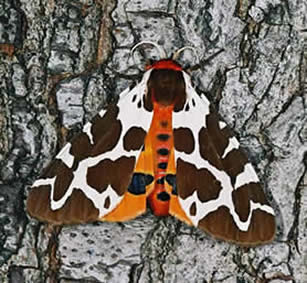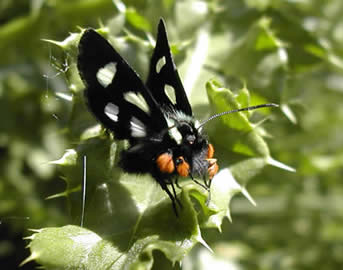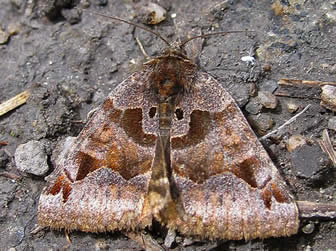

THE MOTHS OF BRITISH COLUMBIA

Garden Tiger Moth (Arctia caja) , photo by Steve Ife
Introduction
by
Rob Vandermoor
Click here for a 2008 list of the Lepidoptera of BC Click here to read the general introduction to the Lepidoptera Click here to look up any moth species in North America |
Silent in the night and rarely venturing into the realm of daylight, moths belong to the order Lepidoptera that is shared with butterflies. Moths, unlike the better publicized butterflies, have always been mysterious to many and little understood by most. Many people would have no problem allowing a butterfly to alight on them, and may in fact find it exhilarating, but if a moth were to do the same, they most likely would want the experience to end as quickly as possible. For many, this is partially due to having only the most basic understanding of moths and how they compare with butterflies.
Superstition and folklore are still prevalent in some countries where moths are considered by some to be a sign of general misfortune and in some cases where the ”Black Witch moth” Ascalapha odorata is found, they are sometimes thought to be a harbinger or precursor of imminent death. Another folklore myth is in respect to the larva of the “Isabella Tiger moth” Pyrrharctia Isabella. The larva of this species is commonly referred to as the “Woolly Bear.” These larva are covered with a thick carpet of bristly hairs that are black in color at both ends and rusty orange in the middle. Folklore has it that the wider the black bands at the ends, the colder the winter. Variation in color and pattern is common amongst moths and larva and this variation in the Woolly Bear larva should not be considered to be a method for forecasting winter severity.

Langston's Foresters (Alypia langtoni), photo by Rob Vandermoor
For the most part moths are extremely similar to butterflies including physiology and life cycle. Many species of moths, unlike butterflies, do not have working mouth parts and, therefore, are unable to feed and rejuvenate themselves. These moths generally have a life span of approximately 7 days, while moths that do feed, generally have a life span of approximately 30 days. In the most vague terms, to satisfy a general understanding of how moths differ from butterflies, it could be said that moths prefer the cover of night where butterflies prefer the daylight hours. Moths tend to become active only at night where they go about the same business as butterflies, feeding on nectar and other food sources, mating and laying eggs. This nocturnal preference applies to most moths but certainly not all. One example of this is the Sphingidaefamily, commonly known as Sphinx moths. A number of Sphinx moth species in BC are active only during the daylight hours where they can occasionally be seen nectaring at flowers. With roughly 2,000 species of moths in BC, they outnumber butterflies roughly 10-1 but are noticed to a lesser degree because of their nocturnal habits.
Moths can be found in BC in almost every type of habitat. They range from the lowest elevations to nearly the highest, excluding possibly only the elevations that are never free of ice and snow. Moths are generally considered to be drab and un-interesting in comparison to butterflies, but to the moth enthusiast nothing could be further from the truth. Many moths in BC and around the world have some of the most vivid coloring and cryptic patterning imaginable and put many butterflies to shame. The various moth genera here in BC are well represented and range in wingspan size from less than 1 cm up to 15 cm.
Moth Conservation
Moths, like their better known relatives butterflies, share all of the same concerns regarding conservation issues, with at least one additional concern - artificial lighting and our current trend to illuminate the night. Moths for the most part are highly attracted to lights and can sometimes congregate in significant numbers around illuminated buildings, roadway signs, lamp standards, etc. where they become an easy food source for birds, bats and rodents. For moth species with large healthy populations, the problems that lights present may not cause any lasting or significant population reductions, but for those species where populations are at risk, these lights can lead them to fall prey to the above mentioned predators in unnatural numbers and could potentially have devastating effects on populations.
Sodium lamps are available for most out door lighting applications and are easily recognized by their orange tint. This type of lamp creates very little UV output and because of this these lamps do not attract moths in the same high numbers as standard incandescent, fluorescent, mercury or multi-vapor lighting. Wherever possible, Sodium or LED lighting should be considered for all outdoor lighting requirements.
Moth larva can cause significant damage to food crops, ornamental trees and shrubs and be forest pests. Pesticide use to control these larva affects not just the target species but also the larva of all species within the targeted area. Lepidoptera and their larva are a very large order of insects with moths comprising the vast majority in BC and are a major food source for birds, bats, rodents, reptiles, fish and spiders so their importance for a healthy ecosystem cannot be undervalued.
Another area of conservation concern is the lack of available detailed data for moths in general. Some of our best data is only for those species considered to be pests of forest or agriculture where there is a financial profit loss equation. Without detailed data it is extremely difficult to understand which species are disappearing, and which are steady or increasing in numbers and, therefore, the viability of certain species may be in jeopardy without us being aware of it.
Habitat Loss
As with all creatures, habitat loss is the primary concern - for moths this is no exception. With roughly 2,000 moth species represented in BC, the habitat they prefer or require can be extremely varied and specific. Some species of moths require little in the way of specific habitat and are quite prolific over a wide range; while other species can only be found sporadically, often only in small niches were their specific requirements can be found. Some of these specific requirements can be in the form of larval food plant availability, shelter from difficult contions, such as wind, rain, snow, sunshine or shade. Many of these niche habitats are extremely complex and poorly understood and, therefore, it is a greater challenge to preserve them.
Urban sprawl, industrial encroachment and our desire to build new highways and roadways into formerly pristine environments all add to habitat loss. Once lost it is rarely recovered and forms the premise for the gradual push of all wildlife outside their natural boundaries where they either adapt or become extirpated from the area. Stopping urban sprawl is unrealistic, but certainly through better planning and study, habitat loss could be substantially reduced.
Predators and Parasites
The moth life cycle is a shooting gallery of predators and parasites from the moment the female moth lays her eggs to the time when the life cycle is complete. Eggs, depending on the species, are laid by the female in a variety of ways. They are either spread loosely over vegetation, adhered singly to leaves or bark or adhered in clusters to leaves or twigs. Once laid, they have no significant defense other than to blend in with their surroundings as best they can. This can be in the form of coloration, texture or stealth placement by the female.
When laid, these eggs become a ready food source for birds, beetles and other insects as well as becoming targets for parasitic wasps. The rate of parasitization within certain species can be extremely high often approaching 100%, so most of these eggs never reach the larval stage. For those larva that emerge from the eggs unscathed, they face a further battalion of birds, beetles and predatory wasps, such as Yellow Jackets or Bald Faced Hornets, looking for a fast meal. If they are lucky enough to escape these predators, the larva now face their most insidious-enemies the parasitic wasps and flies. These wasps and flies lay one or multiple eggs on the larva which, upon hatching, burrow inside the larva. The larva is slowly killed by being consumed from the inside. Adult moths are also at high risk to be eaten by birds, bats, rodents, reptiles, fish, spiders and mammals. In some cases, moths form an important mainstay of their diet.
Study and Collection of Moths
Gaining knowledge and insight into some of the 2,000 plus BC moth species is a life time study with many new species surely to be discovered and insights into life cycles yet to be documented. Whether amassing a voucher collection for scientific study in conjunction with notes regarding dates, times, locations, life cycles, food plants etc or documenting the same through detailed photographs, the experience is immensely rewarding and can go a long way to help us all attain a better understanding of the roll moths play within the flora and fauna in BC.

Aspen Serpentine Leafminer Moth damage (Phyllocnistis populiella),
photo by Werner Eigelsreiter

Toothed Somberwing (Euclidia cuspidea), photo by Werner Eigelsreiter
Links
Butterflies and Moths of North America
A list of moths of British Columbia
Moths of Canada
Please cite these pages as:
Author, date, page title. In: Klinkenberg, Brian. (Editor) 2023. E-Fauna BC: Electronic Atlas of the Fauna of British Columbia [www.efauna.bc.ca]. Department of Geography, University of British Columbia, Vancouver. [Date Accessed]
© Copyright 2023 E-Fauna BC.